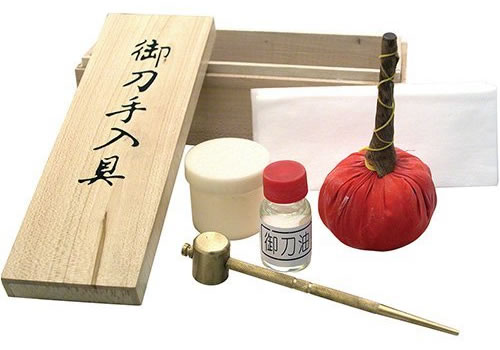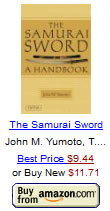
A typical katana maintenance kit. This one includes a wooden box, oil bottle, powder ball & hammer, cleaning paper/cloth and 2 pegs.
Many people buy a katana thinking it’s a strong and quality sword that will be preserved for years to come. True, it often is a quality sword, but owners tend to get disappointed when their sword begins to rust thinking they bought a low quality sword, when in fact they know nothing about it’s proper maintenance.
Typical display-only stainless steel swords don’t need any maintenance, but if you purchased a battle-ready sword you will have to take proper care of it. The carbon, an element the blade is made of is prone to oxidation and rust, which is the main reason why touching the blade and not oiling it will lead to deterioration of the blade.
Here’s a few facts you should know:
- First of all, always be extra careful around a sharp sword.
- You should never touch the blade of a samurai sword, as it will lead to rusting.
- The best way to prevent rust and to preserve sword’s flawless polish it to keep the sword lightly oiled at all times.
- Use light oil, one that does not soil the scabbard.
- Katana swords are best kept in dry and non-salty atmosphere. If in salty atmosphere you should apply the oil once a month, whereas in other areas once every three months is enough.
- Don’t keep the sword in direct sunlight.
- Before you apply new oil to the blade, you should wipe the old oil with a very soft fabric, and use a special oil removing powder, or talcum powder.
- Don’t use metal polish or it will deteriorate the blade. The tsuka (handle) and tsuba (handguard) shouldn’t be polished.
- Don’t try to remove small imperfections on the blade, or those you caused yourself.
- Using mineral oil (Choji) keeps your blade in better shape over an extended period of time.
If you bought a katana without a maintenance kit, you can buy one here. Any maintenance kit for katana swords should contain at least one special bottle of mineral oil (Choji), some napkins, fine rice powder and a special balloon (uchiko). In addition, it also contains a box for keeping your napkin soaked in oil and a hammer to remove the rivets trough witch the blade is fixed in the handle.
Here’s how you use the maintenance kit:
- First, with a thin tissue of rice or a fine cotton cloth strip remove remaining oil from previous maintenance or dirt caused by use. Dirt and stains caused by various organic substances can be removed easily with a cloth soaked in pure alcohol or a solvent.
- After properly cleaning the blade, cover it with powder.
- After this, with a rice napkin polish the blade until no powder remains on the blade.
- Next, apply a few drops of oil on the entire length of the blade, on both sides and spread it evenly all over with a rice napkin or a fine cotton rag.
Make sure that after this operation you don’t touch the blade with your hand and put it carefully back into the sheath. Make sure the oil layer is very thin, if you put too much of it you might get dust gathering inside the sheath. Also, you should avoid the contact between cooper parts and mineral oil, because these could turn black.
The entire process is also explained in the 4-minute long video below:
Remember, it’s always easier to prevent your sword from oxidation than deal with rust stains later on. Samurai swords should be handled with the care and respect they deserve. Hopefully these tips will help you to preserve the value of your swords and enjoy them even more.

Does this same maintenance technique apply to double-edge Chinese swords?